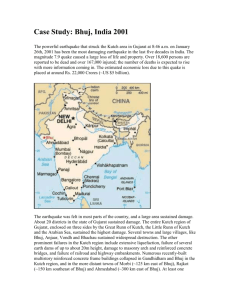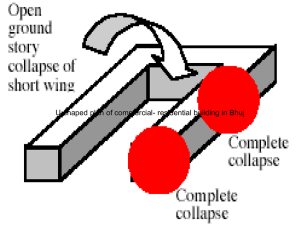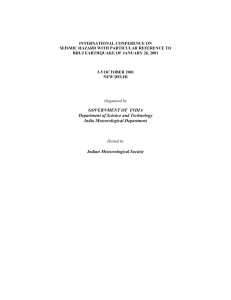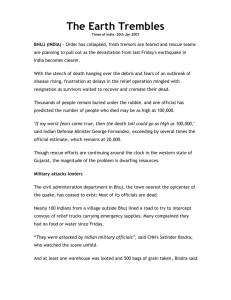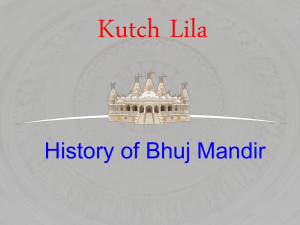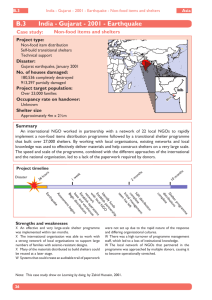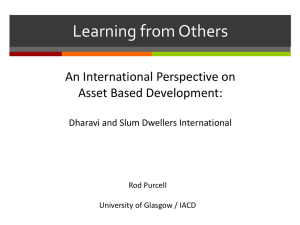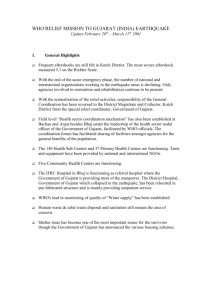Full report
advertisement
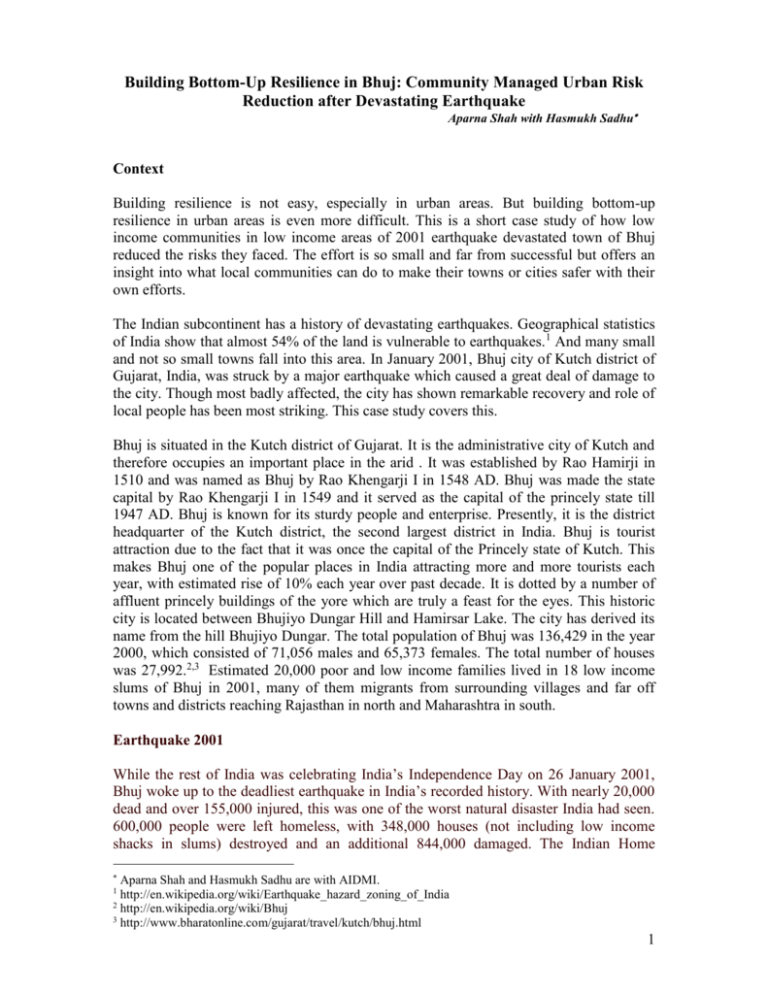
Building Bottom-Up Resilience in Bhuj: Community Managed Urban Risk Reduction after Devastating Earthquake Aparna Shah with Hasmukh Sadhu Context Building resilience is not easy, especially in urban areas. But building bottom-up resilience in urban areas is even more difficult. This is a short case study of how low income communities in low income areas of 2001 earthquake devastated town of Bhuj reduced the risks they faced. The effort is so small and far from successful but offers an insight into what local communities can do to make their towns or cities safer with their own efforts. The Indian subcontinent has a history of devastating earthquakes. Geographical statistics of India show that almost 54% of the land is vulnerable to earthquakes. 1 And many small and not so small towns fall into this area. In January 2001, Bhuj city of Kutch district of Gujarat, India, was struck by a major earthquake which caused a great deal of damage to the city. Though most badly affected, the city has shown remarkable recovery and role of local people has been most striking. This case study covers this. Bhuj is situated in the Kutch district of Gujarat. It is the administrative city of Kutch and therefore occupies an important place in the arid . It was established by Rao Hamirji in 1510 and was named as Bhuj by Rao Khengarji I in 1548 AD. Bhuj was made the state capital by Rao Khengarji I in 1549 and it served as the capital of the princely state till 1947 AD. Bhuj is known for its sturdy people and enterprise. Presently, it is the district headquarter of the Kutch district, the second largest district in India. Bhuj is tourist attraction due to the fact that it was once the capital of the Princely state of Kutch. This makes Bhuj one of the popular places in India attracting more and more tourists each year, with estimated rise of 10% each year over past decade. It is dotted by a number of affluent princely buildings of the yore which are truly a feast for the eyes. This historic city is located between Bhujiyo Dungar Hill and Hamirsar Lake. The city has derived its name from the hill Bhujiyo Dungar. The total population of Bhuj was 136,429 in the year 2000, which consisted of 71,056 males and 65,373 females. The total number of houses was 27,992.2,3 Estimated 20,000 poor and low income families lived in 18 low income slums of Bhuj in 2001, many of them migrants from surrounding villages and far off towns and districts reaching Rajasthan in north and Maharashtra in south. Earthquake 2001 While the rest of India was celebrating India’s Independence Day on 26 January 2001, Bhuj woke up to the deadliest earthquake in India’s recorded history. With nearly 20,000 dead and over 155,000 injured, this was one of the worst natural disaster India had seen. 600,000 people were left homeless, with 348,000 houses (not including low income shacks in slums) destroyed and an additional 844,000 damaged. The Indian Home Aparna Shah and Hasmukh Sadhu are with AIDMI. http://en.wikipedia.org/wiki/Earthquake_hazard_zoning_of_India 2 http://en.wikipedia.org/wiki/Bhuj 3 http://www.bharatonline.com/gujarat/travel/kutch/bhuj.html 1 1 Department estimated that the earthquake had affected, directly or indirectly, 15.9 million people, which was nearly 50% of the population of Gujarat. The old part of the town was severely damaged, with 3 to 4 storey high buildings turning into rubble. More than 20,000 cattle were reported killed. Direct economic losses were over INR 65 billion (USD 1.3 billion), although more estimates showed that losses may have exceeded INR 250 billion (USD 5 billion).4 These losses did not include losses of informal settlements and employment of the poor. The state administration, Government of India, officials, local and surrounding communities, local NGOs and international humanitarian agencies rushed to Bhuj for rescue and relief. However, most prompt, long lasting, and generous support come from the neighbouring homes, villages, districts, and communities. Peopleto-people direct support was overwhelming but not recorded. Some estimate this lateral support to be two times more than the top-down support. The World Bank and the Asian Development Bank had announced loans worth $300 million and $500 million respectively. UNDP and these two banks launched first ever point assessment mission to map out nature and extent of need for support. A number of other bilateral agencies including, European Union (EU), Department for International Development (DFID), United States Agency for International Development (USAID), and Canadian International Development Agency (CIDA) had also agreed to provide financial assistance for the rehabilitation program.5 Smaller but significant international NGOs such as CORDAID and Concern Worldwide and American Jewish World Service provided direct support to groups of dalits and minorities. Compared to Bhuj 2001 earthquake, the Kashmir-Pakistan earthquake in 2005 resulted in great number of fatalities as a direct result of an earthquake in south Asia in recorded history. It superseded the number of fatalities in South Asia from the Sumatra-Andaman earthquake in 2004.6 The European Union had pledged $4.4 million in relief aid after the Kashmir-Pakistan earthquake. In addition, the World Bank had also offered Pakistan $20 million in reallocated funding for reconstruction. ADB also committed $10 million in reallocated funds for immediate emergency assistance for rehabilitation in Azad Jammu and Kashmir and the North-West Frontier Province.7 However, Bhuj remains unique in its loss and also in its robust recovery. The Initiative On January 27, 2001, by early evening the All India Disaster Mitigation Institute (AIDMI) team – then working in three districts in Gujarat and now working in 6 states of India – was camping in front of the collector’s office, assessing needs, and developing response plans with material support from the first visiting team of DFID on the second day. By January 31, it was clear to AIDMI that the city of Bhuj will not need additional relief material since it was apparent that the relief material was in abundance. Some reports estimated that never before so much relief was mobilized by both, local communities as well as international humanitarian system. But the link between the relief providers and the needy was lacking. Thus, relief coordination and communication was the angle point where AIDMI set its focus. Excellent work was already initiated by utch Excellent work was already initiated by Kutch Mahila Vikas Sangathan of poor women 4 http://www.hopefoundation.org.in/disasterrelief/bhuj.aspx http://irp.onlinesolutionsltd.net/assets/recoverycases_reports/ADRC_Gujarat.pdf 6 http://asc-india.org/menu/gquakes.htm 7 http://www.adb.org/Documents/RAs/south-asian-earthquake.pdf 5 2 with UNDP and AIDMI efforts added to such coordination initiatives. From July to October 2001, AIDMI evaluated the response of Disaster Emergency Committee (DEC) agencies – 14 most prominent international NGOs from UK such as Oxfam and Action Aid – after the earthquake. The evaluation findings revealed that in Bhuj some communities were not included in the relief even thought it was the main melting pot of all the relief work at the beginning. NGOs and the government were bypassing slum communities – communities where the poor and informal sector workers lived in estimated 18 locations – which even before the earthquake experienced low standards of living. The slum areas were not part of the town reconstruction plan; they were left out of the process as people in low income communities did not have land title and were with entitlements. Also, many NGOs left after responding to the immediate disaster crisis response neglecting the post disaster needs of urban slums. AIDMI saw it as its duty to help those most vulnerable and left out of the society. With the experience from working in urban slums of Ahmedabad and 23 Nagarpalikas (small towns), an in-depth examination of Bhuj initiated the Bhuj Reconstruction Project (BRP).8 AIDMI built on its work with Oxford Brooks University on Action Planning for low income community recovery. This work was upscaled by work with large three district vulnerability assessment with Indira Gandhi National Open Universtiy. Prime Minister’s Office provided initial support to disseminate safer building construction technology in low income communities. Goals and Objectives Data, through surveys, PRA tools and field visits, were collected in 37 slums of Bhuj. Out of these, 18 were most badly affected. The surveys were done by youth in low income communities after need assessment training was provided to them. The surveys revealed that a) the slum areas in Bhuj did not get more that 65% relief coverage; b) in some slums the compensation payment was as low as 60%; and c) hardly any slum dweller was aware about the new town plan for Bhuj in his or her place. The surveys and visits by AIDMI teams also showed that even after 12 months of relief and rehabilitation the slums in the main town of Kutch were populated with victims in need for livelihood relief, shelter assistance, and civil society interventions. Thus, the BRP began in January 2002 with three objectives: a) to build and increase livelihood security; b) to improve and promote shelter security; and c) to give poor victims a voice in the new town planning process of Bhuj. Out of the 37 slums of Bhuj, 18 most affected were selected for the BRP.9 Impact and Results The livelihood security of the poor and vulnerable slum dwellers was built and increased by providing them livelihood relief through AIDMI’s existing Livelihood Relief Fund (LRF). It was found that what the poor wanted was work that brought income and built assets, including shelter. Work was transforming activity from humanitarian intervention to long term economic recovery. Work transformed relief to development. The LRF provided livelihood assets or material or tools to those affected victims whose livelihood Experience Learning Series on ‘Urban Development and Disaster Mitigation’, Issue no. 20, November 2002 9 Experience Learning Series on ‘Urban Development and Disaster Mitigation’, Issue no. 20, November 2002 8 3 was lost due to the devastating earthquake. This included a range of economic activities such as shoe repair, machine tools making, hair cutting salon, biscuit making, cycle repair, tube light repair and mobile phone vending in addition to vegetable selling and laundry and diamond polishing. This helped the beneficiaries to immediately revive their means of working and restart their earnings. The livelihood relief also helped the beneficiaries to secure the other three human securities – food, water and habitat. Income flow increased food intake, added water sources, and improved habitat. Income led to assets that lead to shelter repair and building new shelter where needed. A direction for growth was set. The timely livelihood relief helped the families get out of the tense economic situation. Even a year after the earthquake one out of five families were without shelter and had to sleep outside with their young children struggling for safety and warmth. They were exposed to the harsh elements of nature and social risks of violence and theft. To allow them a life in dignity and safety, AIDMI was involved in the construction of new safer shelters for the earthquake affected victims of Bhuj slums. The beneficiaries of the shelter support were very happy with their new homes that they had planned, estimated, laid out, built and finished. Small, one-room, white-washed homes shined in low income communities through out Bhuj. They pointed out that their children’s health improved since they had a safer shelter and they were protected from the heat and from stray animals. They were also able to concentrate on their livelihood since they knew their families were safe. There was a place to store material and trade produce, and meet clients. The spots of loss became economic hub. City economy stimulated bottom-up. City markets required bottom-up. For the widely hit city of Bhuj, a Town Development Plan (TP) was developed by the Government of Gujarat with international inputs. The TP was only valid for the Walled Town area and thus the slum dwellers living in the surrounding areas could not contribute to the TP; they were simply left out of the process. And all the slum areas were located in the surrounding areas and they were not part of the reconstruction plan, though both areas were part of Bhuj town. The slum dwellers were affected by the Development Plan (DP), which comprised the entire area of Bhuj municipality. The public had not been involved in this plan as much as all the involved agencies wanted to. To involve poor people in the planning process is not easy. In short, city planning in Bhuj suffered from a crisis of confidence, growing failure in its ability to deal with rehabilitation schedule of the citizens, and its consultation process without providing basic information. Under these conditions, AIDMI, within its ability and capacity supported slum dwellers’ needs and was willing to protect their rights with its limited resources. The main task for AIDMI was to inform people and build their awareness about the Town Planning Process so that the neglected victims can raise their voices and contribute to the town planning. This was done by AIDMI through various publications and local capacity building cycles that brought basic information about the town planning process to the people. People wanted to know more and had very good suggestions about how to build better and safer Bhuj. Through dissemination of information material and numerous training courses, the number of slum dwellers who had no idea about the Town Plan was reduced considerably. They went to various authorities on their own and made their case on their own. Some met with success and some did not. Some citizens also took the first step and contacted the authorities to seek assistance for the follow-up procedure. There was a demand for a resource center from where the citizens can get correct, reliable and up to 4 date information about the town planning issues and their status in the town planning process.10 Risk was addressed where it matters the most! At the lowest level. Besides the above, strong attention was given to area and community development through capacity building by AIDMI. AIDMI had limited resources but local teams and communities mobilised local people to get water connection, get widow welfare scheme accessed or get more roads in slum areas. One of the important aspect of capacity building is information sharing. Information is power. And accurate information is greater power for the citizens. With Crisis to Celebration (C2C) information centers, the BRP achieved success in sensitizing the community and increasing awareness of their rights as victims and also as citizens. With the help of the C2C information centres, communities managed to address the child labour and child illiteracy rate and promoted practical action. More children were enrolled by the local schools and left out children were enrolled by the local informal initiatives in the communities. By offering education to the children in the slum areas, opportunities were increased for them to have access to better work in future. Informal education and awareness camps helped affected communities know about basic health, education and various disaster mitigation measures. A major achievement for these C2Cs was that many children were admitted and retained into the formal school system. At one point this number was as high as 600. C2C teachers acted as intermediaries between poor families, schools and government officials concerning child registration and the provision of administrative documents necessary for school attendance. Though education is development issue, it is also recovery issue for the poor who face repeated risks. To give a child the opportunity to integrate into official education system ensures a tremendous beneficial impact on their lives. As one mother said to visiting DEC evaluator, “My shelter fell down due to the earthquake but my child’s future has stood up bright in front of me now.” All the above initiatives and interventions were carried out by the Slum Area Committees (SAC) that were set up by slum dwellers for their recovery management in a bottom-up decentralized way. The SACs were formed by the communities of 14 slums in Bhuj where the above mentioned activities were carried out. In each of the 14 slums there were volunteers who were part of the SACs and who led all the initiatives. Many SACs were managed by women. The SACs worked on the development of the community, established community centres and halls, created awareness within the slums, and contacted the local government concerning the basic facilities of the slums such as street lights, sanitation, drainage, and so on. Thus, the SACs accelerated the recovery process and ensured the sustainability of future gains. Improved governance at local level itself transformed humanitarian process into recovery process. The community-generated, participatory nature of the SACs aimed to assist the slum inhabitants in their transition from recovery beneficiaries to rehabilitation partners. In this sense, the SACs were community-run institutions for collective recovery and resilience which empowered households through education and livelihood training and provided an information centre on disaster mitigation. In short, need based, bottom-up, local and community managed process built resilience in local recovery process. Building back better found new meaning. Building was not just shelter but also work, and market and infrastructure, and social relations, and basic services of health and education. Back meant back to its Experience Learning Series on ‘Urban Development and Disaster Mitigation’, Issue no. 20, November 2002 10 5 original levels but also back to its roots and traditions and origins. Better was not always new and big but also safer and well protected. The Good Practice – Participatory Approach Participation of local communities in the BRP was considered to be as much 'instrumental' to the success of the programe as 'transformative' in building people’s capacities for risk reduction. Perhaps, that is what early recovery is expected to do, be instrumental in recovery as well be transformative. The livelihood relief was provided through the demand driven and tailor made approach of LRF. The beneficiaries were involved in the purchase of livelihood assets, materials or tools and they received it according to their needs and requirements. Victims know what they want and know how recovery can build resilience if they are given a chance to do so. In providing the shelter support, AIDMI used an owner driven approach. This approach has been well promoted for rural areas by Abhiyan and UNDP after the earthquake. The owners of the shelter decided what to build, how, when, within what budget, with what material, and over what period. The pace was set by the owner and not the project schedule or the NGO. The shelters were not standardized and AIDMI discussed with every applicant how he or she would like the new home. Beneficiaries themselves decided on their home size, shape and look. The beneficiaries were also fully responsible for the construction of their own shelters. The local volunteers who were the members of the SACs were from the affected community and they themselves took the initiative for the development of their areas and coordinated with the local authorities to get access to the public utilities and basic necessities in their areas. Main focus was on water, sanitation, food, health, education, and work. In a way, the focus was on Millennium Development Goals (MDGs). Working with local volunteers ensured that action was deeply rooted into the day to day reality of the slum community and the services that mattered the most to them. AIDMI continuously capitalized on this strength as volunteers were provided with capacity building training and regular reviews along with active participation in programme review and livelihood relief. As a result, the large allocation of authority and responsibility to volunteers helped achieve community ownership of the BRP project. Often it is assumed that local communities do not want to own the process. In fact development is their process that is interrupted by disasters. The humanitarian intervention takes away the process from the local communities, often in good faith, mostly due to the power of resources and position. Early recovery can and should return this power and ownership to local communities and when this is done, when this is done well, communities become resilient, and in the end many resilient communities make the city resilient, bottom-up. Potential for Replication What is presented here is unique to some slums in Bhuj. That is how it seems but in fact it is not unique to one slum or one town. Slums across India and town across India have this potential to built resilience bottom-up if recovery is well balanced between its instrumentality of delivering services and achieving results as well as in its transformative role of changing flow of funds, ownership of decisions, and countervailing structures. Role of the authorities and civil society is to join hands to secure communities do so during its hardest period. 6
